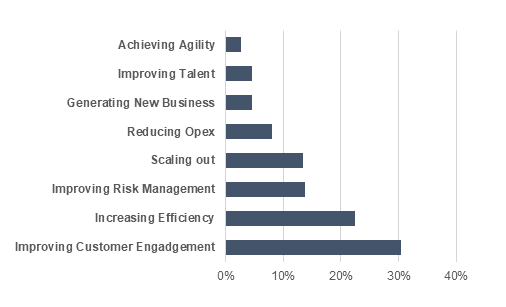
We hear companies announcing success in the adoption of Artificial Intelligence (AI). I took a closer look at the Insurance industry, in particular, to understand what does AI means for them. Upon analysis of over 200+ AI use cases applicable to Insurance companies (all publically available) happy to share some of the insights including use cases that grabbed my attention.
Please note that I’m looking at the type of AI technology and business drives, and do not focus on specific insurance lines of business (e.g. individual, life, property etc.) and/or functional area (e.g. marketing, HR, underwriting, claims etc.).
Let’s explore.
AI offers a variety of technologies and implementation options, which can broadly be grouped across the following domains. The figure below illustrates the adoption level as a percentage.

- Machine Learning (ML) – mostly concerned with data analytics. Solutions based on ML are focused on data capture, quality analysis, and enrichment, pattern identification and eventually visualization or decision making. It many cases organizations see it as an opportunity to automate and improve processes (e.g. claims, underwriting) as well as use more sophisticated rating algorithms with nearly unlimited parameters, factoring things like social media activity.
- Natural Language Processing (NL) – refers to text and speech recognition capabilities often adopted across channels to perform things like claims processing (text recognition), client onboarding (image/text recognition) and in some cases with help of Chatbots to interact with clients.
- Virtual Assistant (VA)– in most of the cases VA provides support to agents with appointment setting, lead generation, customer care, email management, claim report processing and in some cases when bundled with Natural Language Processing (recognition & generation) may be helpful for calls processing.
- Robotic Process Automation (RPA)– technology is often seen as a first step in AI adoption journey and works well to perform a high volume of repetitive tasks. For example, using multiple applications as sources for completing claims processing.
- Neural Networks (NN)– takes more advanced approach to Machine Learning and interestingly is the most popular AI technology application amongst Reinsurers. It is often positioned as a means to transform industry form “claims/settlement” model to the “prevention/protection” model.
What is the typical business motivation?
Top eight business drives represented in the figure below. Note that many business cases do touch upon multiple drivers.

Nearly 70% of the AI use cases are driven by customer experience, risk management, and internal efficiency. This correlates with the overall trend of digital, macro-economic conditions and some of the risk-averse nature insurers. In most of the cases, insurers are implementing use cases that combine 2-3 business drives. Examples from the top insurers include:
- Zurich insurance could improve customer service/engagement by introducing AI-based claims handling. Solution claimed to save 40,000 work hours and cut claims processing time from an hour to few seconds. Zurich also reported that solution supported its growth and improved efficiency.
- Allianz in partnership with Praedicat (Insuretech Company) uses both Machine Learning to scan, analyze and synthesize data from millions of peer-reviewed scientific journals to identify insured product risk. This technology helps Allianz to improve and automate some part risk management practices and continuously adjust relations with customers accordingly.
- As part of a broader transformation program, AXA deployed AI-enabled Personal Assistant for Sales, to improve sales productivity and effectiveness of partner channels to increase engagement and improve business with brokers. Solution provided AXA with 360-degree view of agents, brokers and their engagement activities, correlated sales activities and revenue impact and intelligently schedules upcoming engagement activities.
Please check my blog for more insight around the subject.


